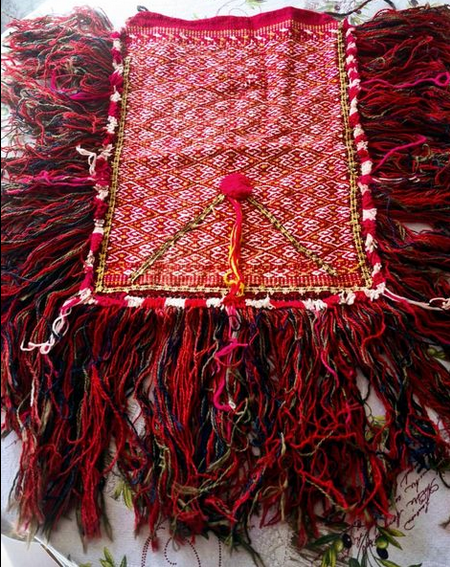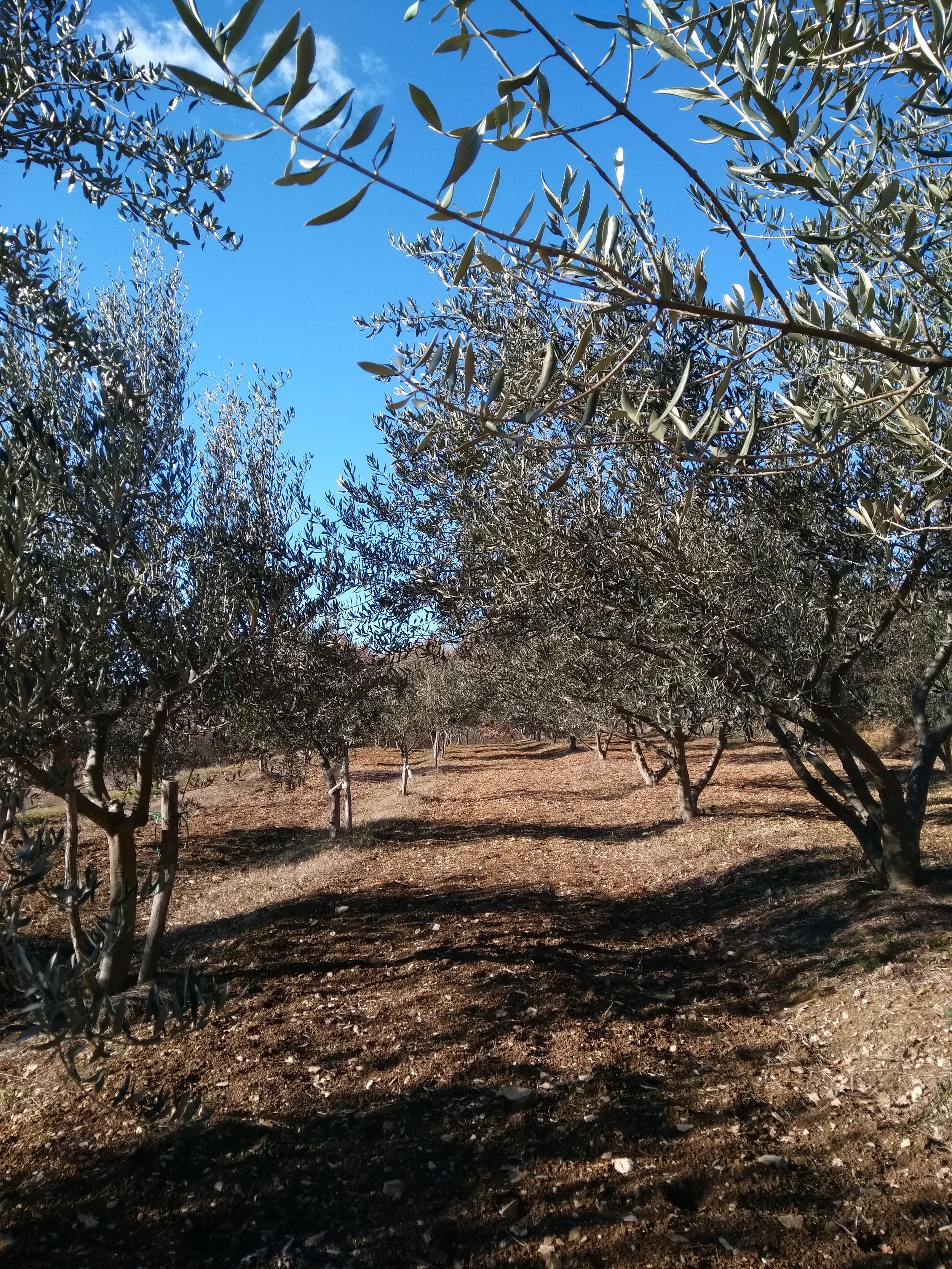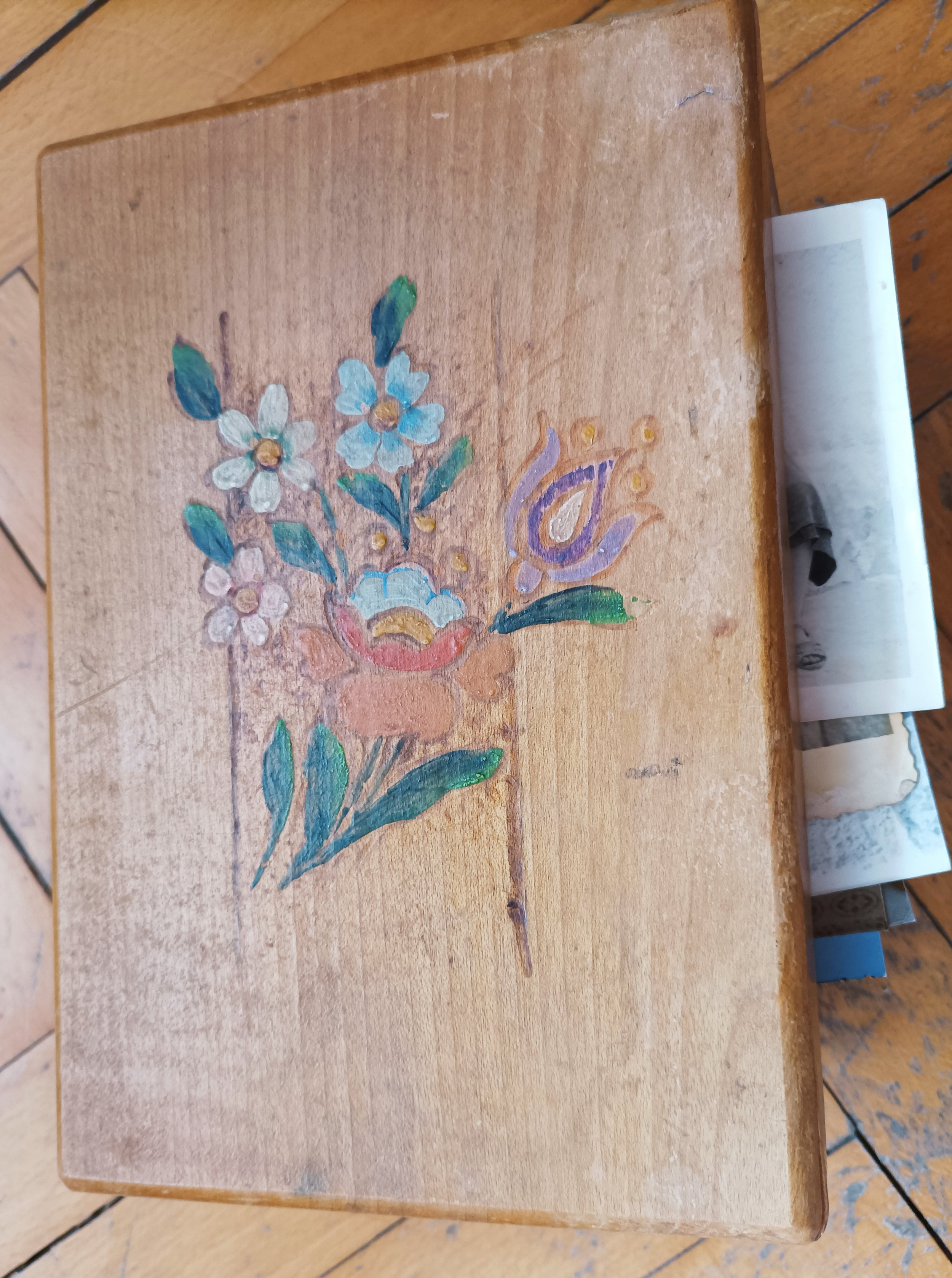Threads of Life
My grandmother (far left) in a traditional dress, wearing a woolen apron.
On the road between Maslenica and Obrovac, facing the Velebit mountains.
I am often asked where I am from. I spent nearly two decades moving around the world, rarely staying in one place for more than a couple of years, and explaining who I am to strangers has become the one constant in my life. When I say “Croatia,” some have no idea where that is. But many meet my answer with the retort: “So much history.” What people mean to say is there’s so much trouble where I come from. History is trouble.
No one knew that better than my parents. A Croat mother and Serb father, ours was a closely-knit family living in the newly independent Croatia during the 1990s. As the demand for national purity replaced the Yugoslav ideal of brotherhood and unity, their marriage turned from exemplary to suspect. It was a time when questioning origins and loyalties was everyone’s business, with unpredictable consequences. The only way my parents knew how to resist was to build our family foundations on a thick bedrock of silence, a past-proof construction designed to keep away stories, voices, and memories.
Of course, I became a historian. But I’m not a rebel; I did it as a distraction. It afforded me a way to look for stories other than my own, the troubles of others to fill the void. But history is treacherous at the best of times, and after a while, my history writing turned into my own primary source.
I dedicated my dissertation to my mother, who died a year before its completion. “To my mother,” I wrote, “who loved nature and delighted in strange stories.” I studied a religiously mixed town in Bosnia and Herzegovina under Ottoman rule, where the coexistence of Catholics and Muslims played out through material and metaphorical engagements with the mountains and streams and forests that surrounded them. The more time passed, the less original my approach appeared. In fact, it felt increasingly familiar. I must have chosen the study of Ottoman Bosnia as sufficiently close but far enough for examining my own roots. And it wasn’t simply that my mother loved nature; nature was our main site of family meaning-making. Although I didn’t understand it at the time, nature could cradle us and root us, while borders and nations spat us out like bitter, sinewy morsels.
My walk into history began much earlier than my doctoral work, in my early twenties and undergraduate thesis. This was a study of history education in 1990s Croatia. I myself was a school student back then, and history was my most feared subject. I could only embrace it once I found myself in the US to do my bachelor’s degree, where an ocean shielded me from Croatian politics. Maybe my interest in history was a way to intellectualize my anxiety when reading about the centuries-old struggles of the Croats for their own state, which was the bottom line of all history we were taught. Integral to that interpretation was also the erasure of the Serbs from the Croatian historical and cultural landscape. On a good day, I sat in history class learning that I didn’t belong. On a bad one, I suspected that everything about the war and conflicts between the Croats and the Serbs was somehow my fault.
I dedicated that thesis to my parents with the line, “To my parents, who taught me to love, not to hate.” The acknowledgements section offered me the only template to express my awareness, and maybe even appreciation, of us being an ethnically mixed family. I squeezed all that was ever ineffable in our lives into a single sentence at the end of a paragraph.
Not long afterward, my father told me he read the acknowledgements. He said, “Thank you,” followed by a muffled cough that I learned to recognize over the years as the sound of discomfort. I imagined that he wanted to say something like this: “Thank you for recognizing the efforts your mother and I made; thank you for acknowledging what we are.” But what I was ready to say on paper, I wasn’t on the phone. I panicked and pretended I didn’t know what he was thanking me for. He must have panicked, too, because he said nothing more.
Then came my master’s thesis, another dive into history. I moved to Budapest and assembled the essay in a little over six months, focusing on seventeenth-century Dalmatia. In that period, Dalmatia was a borderland region, a space where three empires—the Ottomans, the Venetians, and the Habsburgs—met and mingled. Borderland history was all the rage in my program. Borders were all about transgression; ambiguity and fluidity were concepts used to explain almost anything. I read the self-fashioning of various historical protagonists as an invitation to embrace my own ambiguity, as though I could finally begin to assemble language to make sense of myself.
In all this theoretical hype, it took me a while to realize that I was working on the history of my father’s home: Dalmatia. Perhaps this delayed realization of the roots of my research was due to the fact that we never referred to my father’s place of origin as such. In the official Croatian imagination, Dalmatia was a storied land, a national treasure. There lay the cradle of Croatian history, its kings and churches, its olives and the sea. But my father’s family were Serbs, and although they made up an important part of the Dalmatian people, in the new narrative the Serbs were antithetical to the sea, Dalmatia, or, finally, Croatia. I understood this convergence of landscape and social hierarchy once I learned that sea people versus mountain people was one of the core themes of human history. Before scholarship equipped me with tools to understand the workings of othering in nationalist fantasies, placing my father’s Serb roots in Dalmatia was like trying to square the circle. We called his home “dolje” (down there).
In the thesis, I wrote about the Morlacchi, people who moved into Dalmatia from Ottoman Bosnia in the seventeenth century. An eighteenth-century Venetian described them as “a race of ferocious men, unreasonable, without humanity, capable of any misdeed.” A modern-day historian sees them as an “ethnographic enigma.” The ferocious men went on to become Croats and Serbs. These are the people I, too, came from.
Even though there are numerous theories as to how and when exactly the Morlacchi and thus, by extension, the Serbs ended up in Dalmatia, their collective departure has an undisputed date: August 4, 1995. That day and the ones that followed, several hundred thousands of Croatian Serbs, including my father’s entire family, marched through the summer heat on tractors and other vehicles to Bosnia and further on to Serbia, most of them never to return.
The exodus and the violence that both preceded and followed it stand at the core of my family story, a story that I recoil from telling. I suddenly face the problem of context, a precipice familiar to anyone writing about the Balkans: How to tell a story without swirling down years and centuries of conquests, wars, and empires? How to resist, as Edin Hajdarpašić memorably puts it, sending a scuba-diving team into a bathtub?
But my head spins even without looking down into a deep historical abyss. The shallow history within my lifetime is vertiginous enough. I don’t know how to tell what exactly happened between 1990 and 1995—the time when Croatia embarked on a path of independence from Yugoslavia and the departure of the Serb population. I don’t know how to tell why Croatian Serbs refused to live in Croatia and set up the Republic of Serbian Krajina—a quasi-state running through parts of Dalmatia and other regions lining the border with Bosnia and Herzegovina as well as Serbia that in its rejection of Croatia kicked out the non-Serbs. Likewise, I’m not sure how to explain the operation of the Croatian Army that ended it all; now celebrated as a national holiday, it reunited Croatian territories but also made sure that parts of the retaken land remained empty.
All of this meant that I barely knew my grandfather when I decided to dedicate my thesis to him. I spent the war years in Istria, cut off from my father’s family. After the war, my grandparents ended up in Serbia, and we were once again separated by a border.
They returned to Dalmatia in the early 2000s, but our relationship remained distant. Maybe they regarded me with suspicion, saw me as a privileged child who would never share in the grief of their collective experience. Maybe they questioned our loyalties. I certainly questioned theirs. I didn’t want to know how exactly they spent their war years and what their support for Krajina really said about what they thought of our ethnically mixed family.
But I wanted to connect. I wanted to claim some common ground with them as much as I wanted to prove to the world that I, too, had a history. The only way I knew how to do it was to turn to centuries-old stories; they seemed safer than the most recent ones. It was as if an insurmountable gulf stretched between us, a gap that only scholarship could fill. And yet, I never told my grandfather that his name is printed in my master’s thesis, nor did I tell anyone else in my family. I must have forgotten the first thing about history—it’s not only about what happened in the past but what we make of it in the present.
Recently, I looked at the microhistory project of Documenta – Center for Dealing with the Past: countless hours of stories from all walks of Croatian lives and the wars that shaped them. I listened to Serbs and their Croat neighbors telling stories about violence and exile, and I was struck by their vivid recollections of days, hours, and minutes leading to the tragedies and indignities they experienced. Their memories of before and after the traumatic event seemed to have merged into an amorphous blur, but they knew exactly what they held in their hand when they looked at their home or a loved one for the last time. I also thought of my grandfather and how his stories shared a similar structure and how I could never remember anything he said despite the wealth of details.
I wonder now how exactly the experiences that make us who we are lend themselves to creating compelling, meaningful chronologies. When I submitted my story to another publication, the editor urged me toward more historically “enlightening” and chronological storytelling. Was I not a “trained historian,” they wondered. But what degree teaches us to make sense of silences and shame that, like groundwater, underlie conventional historiographies and threaten to well up and inundate them at any moment? Rather than neat historical narratives, memories and fragments of our family lives are more like thick descriptions of the state of being. They are stories recorded in our bones, indistinguishable from the body. I am a historian and I believe in telling history. But I also know that I’ve been looking for my own history in the wrong places.
The old blue wooden door to my father’s family house in Dalmatia
It was in the spring of 1996 that I saw my father’s ancestral home in Dalmatia for the first time. On May Day, my parents put my sister and me in the car and headed south, following the meandering road between the sea and the bare ridges of the Velebit mountains. Since 1996, my family has traveled this stretch countless times; it became a familiar journey in the most literal sense, with the mountains as a family backbone. But back then I didn’t know where we were going, nor if anyone was going to meet us there. I was nine years old.
Less than a year had passed since Croatia proclaimed the end of the war—and since the departure of its Serb population. In Istria, a triangular peninsula jutting into the Adriatic and cut off from the rest of the country by the mountains, we avoided the brutality of the war. But not even Istrian isolation and proverbial tolerance shielded us from the demands for national purity. My ethnic awareness while growing up was like a twisted version of The Emperor’s New Clothes: everyone around me knew that I was a half-blood, but felt too sorry to say it out loud.
I knew it, too, but was too ashamed to think about it. I must have figured it out by putting together my parents’ silence and what was heard from every TV: President Tuđman’s speeches and scaremongering about the evil Serbs. I remember feeling surprised when I eventually realized that the sole purpose of TV was not to broadcast the president. I didn’t understand the geopolitics of the conflict, though, nor what role my family and I played in it.
Our destination was a secluded village, perched deep in the canyon of the Zrmanja river. Until recently only an unpaved road led to it, but once you pass the last ravine and emerge on the small plateau, sharp mountain ridges line the northern horizon, stretching as far as the eye can see. It feels as if you have just arrived at both the remotest and most central place on earth.
In order to reach Dalmatia, one has to cross a narrow sea strait. “Maslenica,” I remember my parents saying once the road reached the edge of the bay. I don't think this word meant anything to me back then, but now I know that they weren't simply referring to a toponym. They meant a bridge, a gazelle-like arch that connected Dalmatia with the rest of the country, which was blown up in 1991. This was a turning point, a rupture both in terrain and time—the burning of communal bridges. I looked around curiously as we drove over the replacement pontoon, a rusty construction that swayed gently underneath us on the evening waves.
When we finally arrived, we were met by a loud, aggressive silence. Although it was the height of spring, not even birds could be heard. Only the wind hadn’t yet given up on the place, stirring the young leaves. Occasionally the mooing of a wandering cow came from the distance. We had seen some of them grazing by the roadsides. I’m not sure how I made sense of them at the time, but as I learned later, it was all pretty simple. As the Serb villages suddenly emptied, all of their animals were left behind to wander freely, perhaps the only ones truly liberated. But not for long. The reports told of trucks that took them away, one load at a time. In the months that followed our visit, the cows we saw would be gone too.
My father was born in a stone house in the middle of the village tucked at the edge of a canyon. The house itself is carved into a rock, almost elegant in its simplicity, its only decoration a row of large rectangular stones that lines its edges. It presides over an assembly of smaller stone huts that, as my father recalls and some history tells me, nameless generations inhabited together with the sheep.
By that time in 1996, the house had been without occupants for ten months, but not without visitors, as we immediately understood. All the doors and windows were broken. The house was gutted. The meager peasant possessions were strewn across the floor, soaked in rain, and buried under the heaps of pine needles and mulberries swept in by the wind.
Just like we didn’t talk about our family in Istria, we didn’t talk about it in Dalmatia either, even though the story of my father’s family, their possessions and their absence, lay eviscerated in front of us. Stunned, my parents wandered from room to room, muttering about the mysterious “oni” (they) that apparently did all of this. I had no idea who “they” were, although now I understand that they could have been anybody, our friends, relatives, respectable citizens.
The first things to disappear were the luxuries. So anything that could be plugged into electricity or sold as metal scrap. I used to wonder if the looters were mad that they didn’t find more valuables. Maybe they compensated for not finding a washing machine by ripping open the pillows and knocking out a door frame even though the door was already gone. Much later, I read the following from Rebecca Bryant: “plunder in a small town is not only an act of greedily absconding with another’s property but an act of power. It’s an act directed not at the objects but at their owners.”
One thing alone defied the otherwise predictable logic of looting. In the kitchen, a seemingly untouched pan of charred peppers was still on the wood stove. The remains of the last supper were like a scene from Pompeii, a carbonized testament to a former life and its abrupt end.
My sister and I were left to piece together the answers to any questions we might have had. We scouted around, never before having seen a similar state of disorder and of potential wonder. Decomposing embroidery, linen, and undergarments covered almost every surface, exposing intimacy and secrets for everyone to see and step on. Shards were everywhere. We waded ever farther into the putrefying mass of past possessions and heirlooms that never were, even at the risk of falling or getting cut. This was the only way, and this our only material, from which to mold some meaning, maybe a memory.
The house, not the parents, spoke to us. Inside, rot gripped the air. The smell of immortelle mixed with damp wool, piercing and medicinal at once. In our rummaging through the playground of the abandoned life, we did eventually happen upon a dead goat. It lay there, white as if painted, on the splintered wooden floor, framed by the afternoon sun. I don’t remember who disposed of the animal and how, but even after it was long gone and the house scrubbed clean, the distinct whiff of decay never really went away. Untold stories stick to our skin and linger in the air, even when no one is left to tell them.
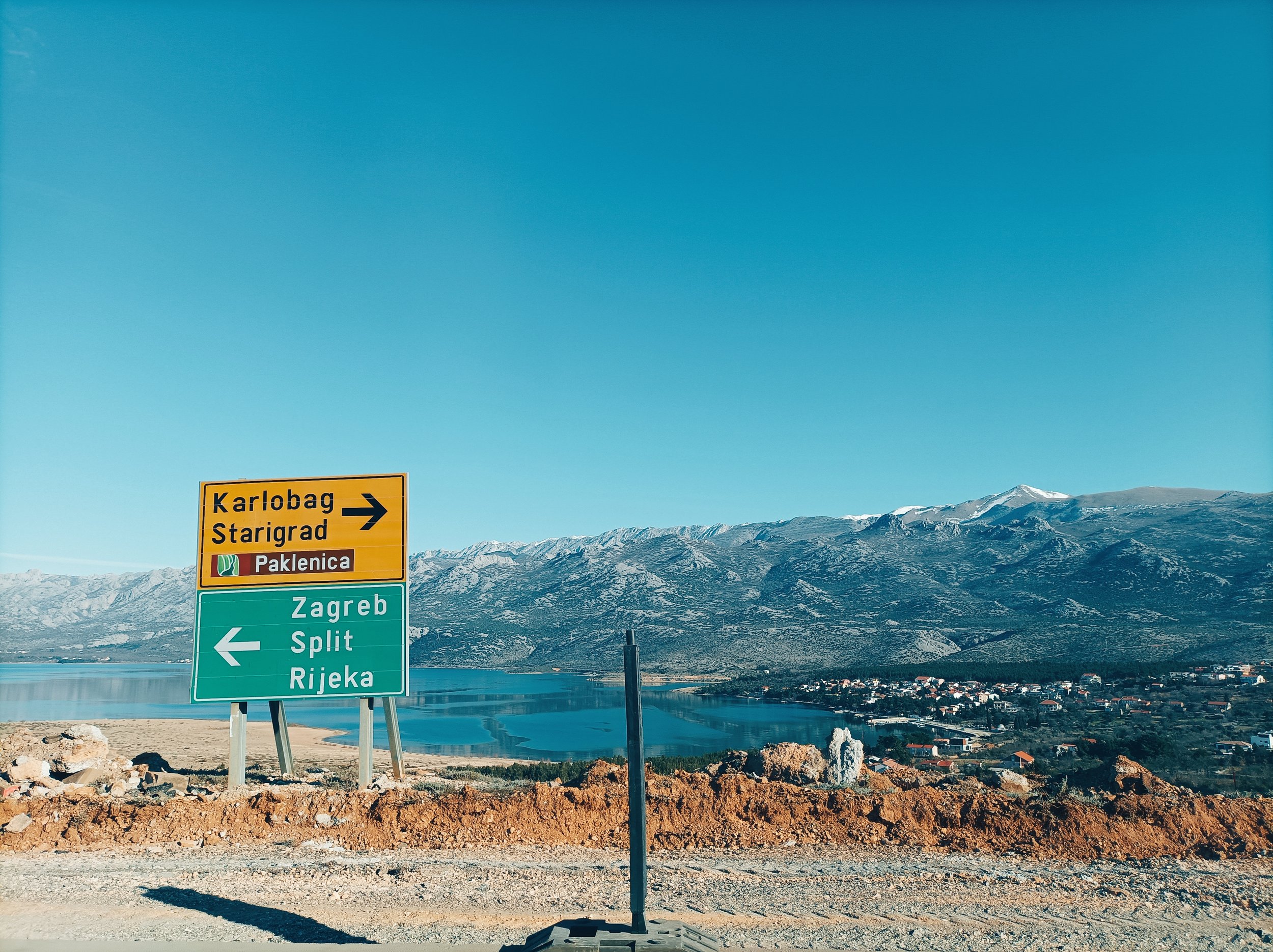
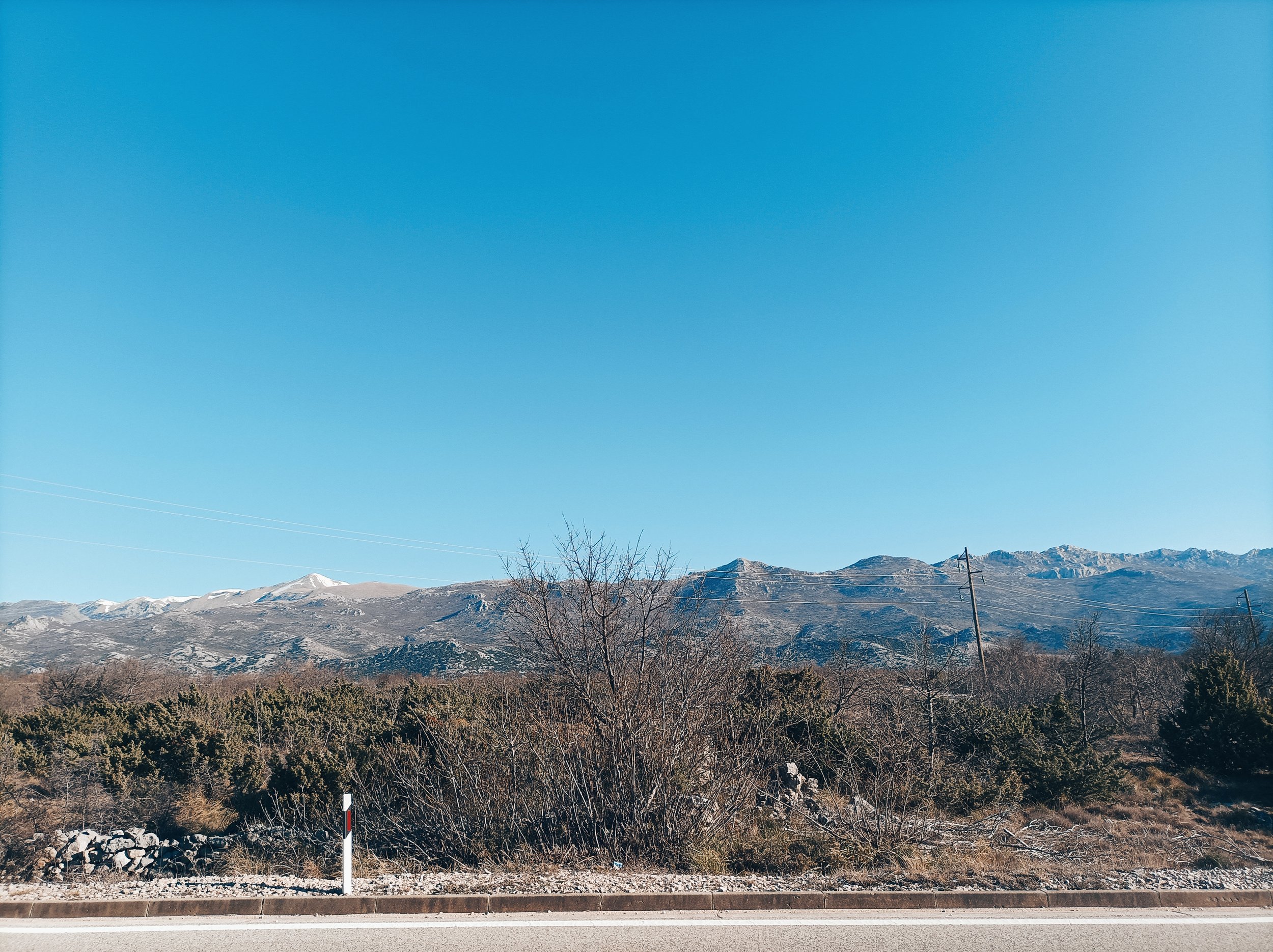

On the road to the village | Southern Velebit in the background | Village landscape at the edge of the Zrmanja canyon
I don’t know how my father felt witnessing the entire landscape of his youth being stripped of life. That day he brought a video camera and captured prolonged, meditative scenes of the house and the village. When he showed his footage a couple of years later to our family, huddled around the TV in my aunt’s Belgrade flat, everyone could recognize something of theirs in a pile or a corner that the camera zoomed in on. “My school notebooks!” my cousin exclaimed. I always wondered whether my father used the camera to document losses or as a filter that would prove that all of this was but a third-rate movie.
I learned over the years that it’s pointless to ask my parents how they feel or what they think. The only way to know them is to pay attention to what they do. And indeed, the house became a project for him and my mother. Plundering visits continued for years and the two tried to put it back in order. They cleared out the rubbish, burnt the rotting woolen blankets, washed and arranged the disappearing kitchenware, knowing full well they would find everything back on the floor the next time. Toward the end, when there was hardly anything left to take or throw, they would come upon empty floors but found the electric wires hanging, ripped out of the walls.
Throughout this war of attrition, my parents didn’t salvage much from the house. It was as if they felt that taking something away would be an act of desecration, like robbing a grave. The only things they brought to our house in Istria were a small box of photographs, two framed family portraits, and a wooden plate, its bottom darkened from decades of holding flesh and fat. “This is at least a hundred years old,” said my father recently. Holding the plate, he told me about his own grandparents: one plate, one spoon, one cup—the household sharing one of everything. Only children and sheep were many. He promised to pass the plate down to me so that I, too, can partake in the long tradition of meal sharing.
My father also salvaged my grandmother’s woolen aprons. I know nothing about my grandmother. She went mute during the last war, after losing a son and suffering a series of strokes. At least this is how I understand the chronology and causality of her condition, which I gleaned from her silence and occasional comments and glances from other family members. But as I examine the aprons, I realize it’s these rough textiles that allow me to weave her into some sort of history. I finally found a thread that leads from the land she came from to the bristled leaves that sprouted from it, to the grazing flocks of sheep that my grandmother tended and whose wool she shore, from there to the yarn she spun, and finally to a story told and recorded. In one of my readings, I spotted the aprons in Delightful Dalmatia, a travelogue by the American enthusiast Alice Lee Moqué who traversed Dalmatia in the early twentieth century. Now absent from history and memory just like my grandmother, the Dalmatian women and their aprons were hard to miss when Moqué strolled through the marketplace in Zadar and observed their “barbaric gorgeousness”: “Marvelous creations … showing bouquets of blue and green roses … in colors which would put to shame one of Turner's most vivid sunsets.”
But more than saving the bare walls, my parents nurtured the trees. An old hackberry on the south side shielded the house from the merciless summer sun, and a mulberry guarded the entrance on the east. There were the almond groves, and there was a fig, fragile but eager to suck up all the remaining life and turn it into sugar inside its purple fruits.
Last summer, I walked through their garden in Istria. Next to the pink peony, my mother’s favorite flower, which started blooming only in the spring after she was gone, grows a young hackberry. Just a bit above the ground its silvery trunk splits into two graceful bodies, reaching ever more toward the sky. This tree was once a slender sapling taken in front of my father’s Dalmatian house and transplanted into the soil my mother inherited from her mother, who inherited it from her own mother. That’s when I finally saw the workings of my parents’ inner lives. For Inara Verzemnieks, landscape is lineage. It is also a language. All their planting and pruning was an intellectual project in which the trees constituted an ideal manifestation of history: their roots firm, deep, but hidden away, yielding fruits and shade year after year.
My grandmother’s apron | My parents' olive grove in Istria | The box of photographs saved from the Dalmatian house
For my grandparents and others like them, moving to Serbia meant becoming refugees rather than coming home. But when they wanted to return and claim their homes and documents, Croatia didn't welcome them back with open arms either.
With the archives gone and people fleeing without papers, many struggled to prove the most basic facts—their very names or that they were born on Croatian soil. While I made my way through the pile of stuff scattered in the house that day in 1996, I came across my grandmother’s ID card. That was when I realized she was illiterate; I noticed that instead of a signature, it featured a big black print of her thumb. I tossed it away and continued digging.
We don’t know what happened to the card, even though my parents searched frantically when trying to arrange for my grandmother’s return. But the fingerprint is etched in my memory—a testament to her identity and a question mark over mine. The only thing I do is write (although these days I usually type), and if I hold the pencil for too long, I get blisters. I imagine her hands: rough and leathery, not from holding a pen but from collecting firewood and carrying barrels of water. As my father explained, these were the women’s tasks to be done before everyone—the men—got up in the morning.
I don’t know how to find the threads that tie us together into a story. Sometimes it seems that I have only two options available, as if my origins are hostage to history tropes. One is the story of progress, of each generation representing a historic leap. The other is the erasure of the gap altogether, where I am but a reflection of “barbaric gorgeousness”: gorgeous perhaps, but barbaric all the same. My grandmother had only her body to tell stories. I have nothing but words. Not even my thumbs. At one border crossing after another, my fingers don’t cooperate with the scanner. “Press harder,” the officer demands as my body refuses to leave traces. “Your hair is just like baba’s,” my mother used to say. Thick and unruly, with a mind of its own. The threads to claim and cherish.
All across the region, houses and humble homesteads continued to crumble, bushes stretching their thorny arms through broken glass windows, supple young trees breaking through roofs. Transmission lines stood listless, cables dangling and clapping in the wind, if someone hadn’t stolen them already. The only current running through the land was ethnic tension, people charged with trauma and mistrust. To deter the displaced Serb population from coming back, the state let the area recede into the Stone Age, undoing the little infrastructural progress of previous decades.
In the village, though, it was the receding of stone itself that exposed the extent of neglect, and ultimately, of erasure. In witnessing the loss of his home, my father spoke in the language of landscape. The village around his house is a textured quilt stitched from rocks. White and gray ridges cascade from the southern tips of the mountains into the sea, and the river cuts through the monochrome like a turquoise vein. But in the absence of herds of goats and sheep clearing the slightest signs of vegetation, the landscape he had known was turning greener at unprecedented speed. Now, willows and reeds embrace the riverbank. Oaks and hornbeam shrubs stud the escarpments of the canyon where no living being, except for an occasional hawk, was known to exist. For my father, this green revival has been a sure sign of his own demise.
We visited more frequently after my grandparents returned. However, the return was hardly a new beginning, nor was it a continuation of anything that came before. Even though my grandparents longed for their house, they also considered post-war Croatia an alien land that would never become theirs. Whenever we came to visit, before even reaching the door, we would be met with loud voices from the Serbian parliament, which my grandfather couldn’t stop watching. The more I tried to understand my own place in Croatia, the less I made sense of their fractured lives.
I struggled with communicating with my grandparents, so I focused on landscape and literature in a way that was bookish, teenage, and hopelessly romantic. The rocks and rivers of Dalmatia fascinated me. I knew that my connection to the region made me different, suspect, and misplaced, but its landscapes also offered me possibilities for reinventing myself in ways I couldn’t understand at the time. I devoured stories about the Dalmatian hinterland, novellas about the peasant wilderness with scenes of star-crossed lovers on the barren, moonlit slopes over Zrmanja. I wanted to see this desolate landscape in all its romantic glory by mapping on to it my precocious yearnings. Eventually, I left.
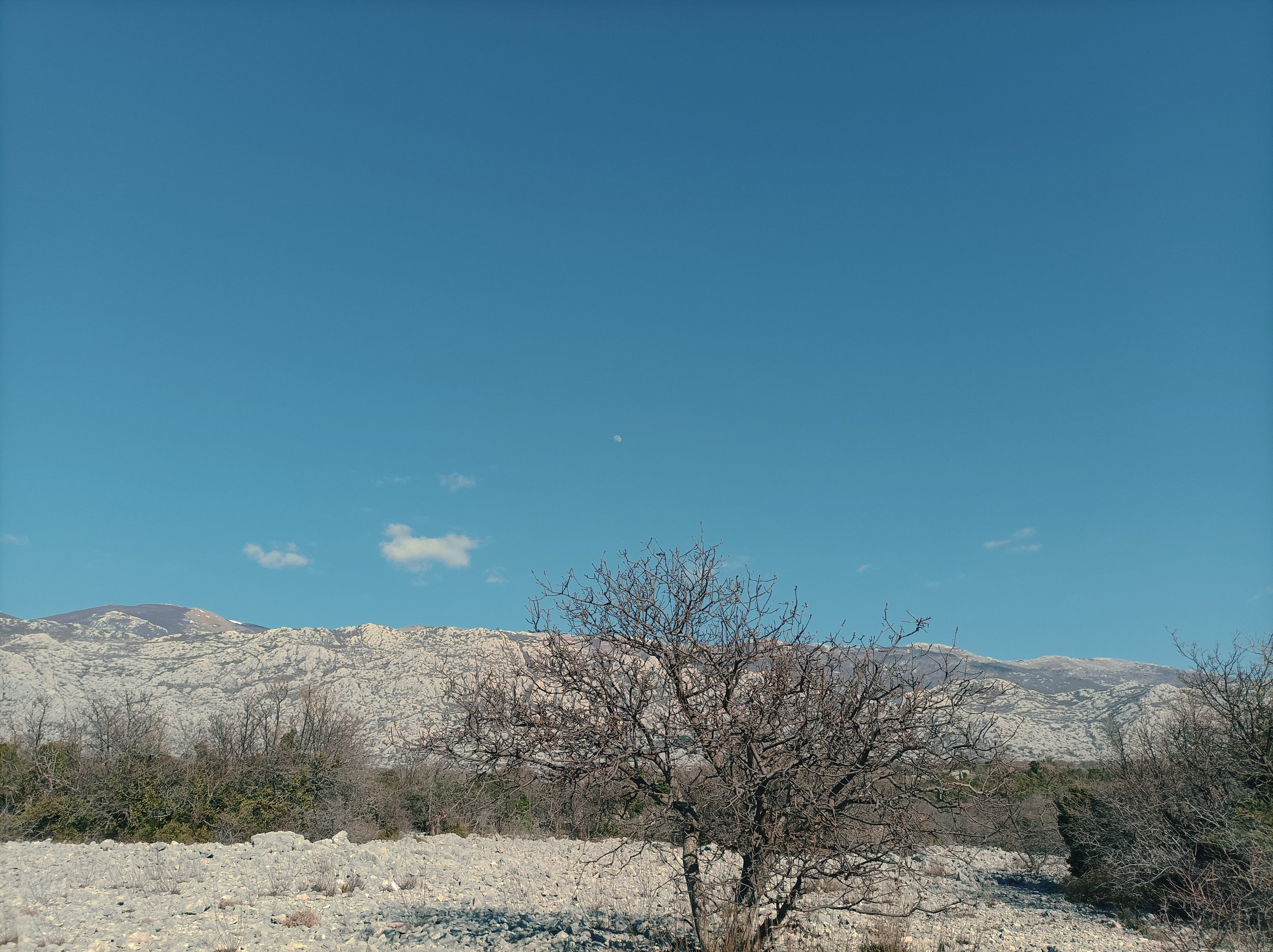
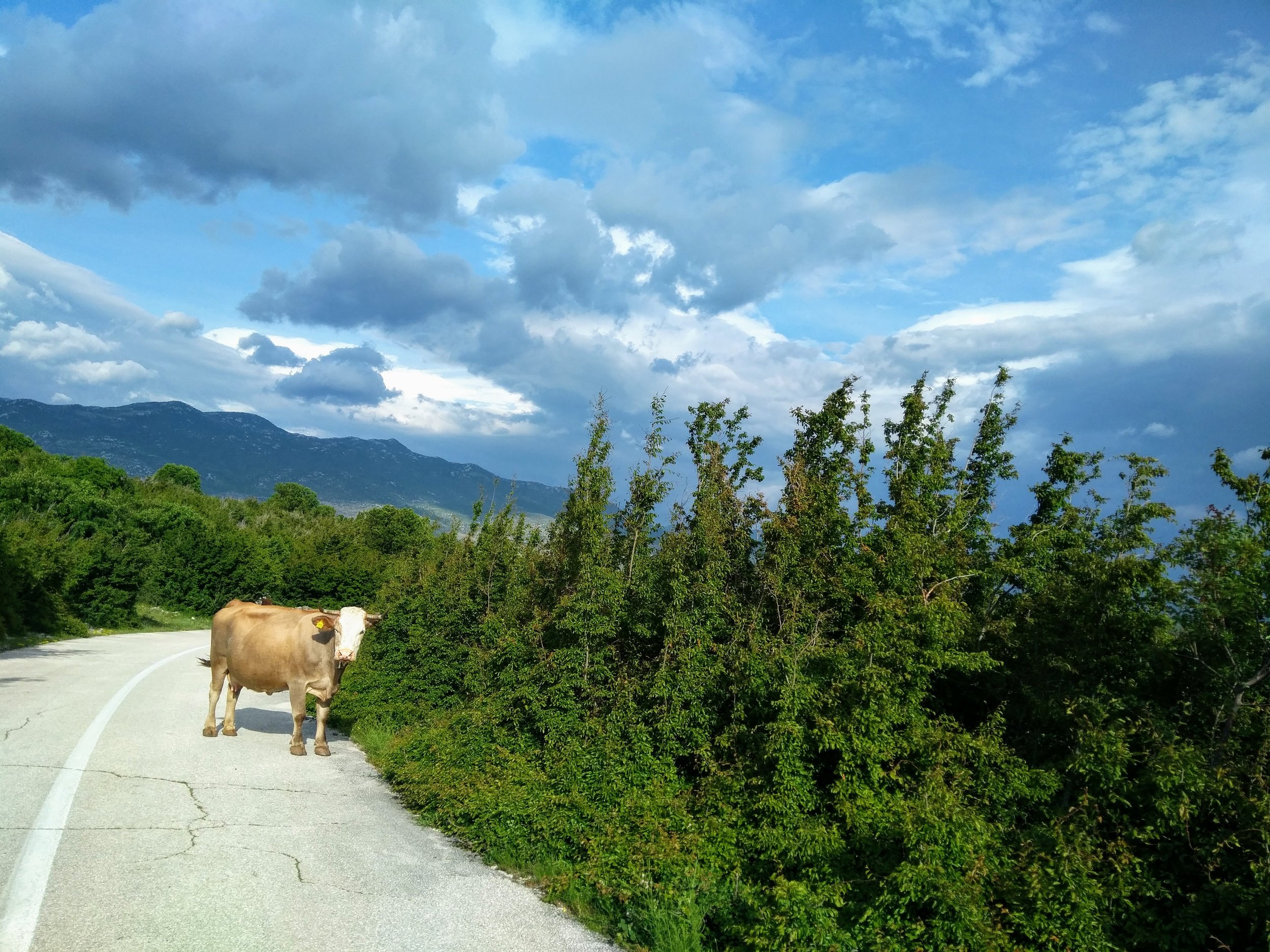
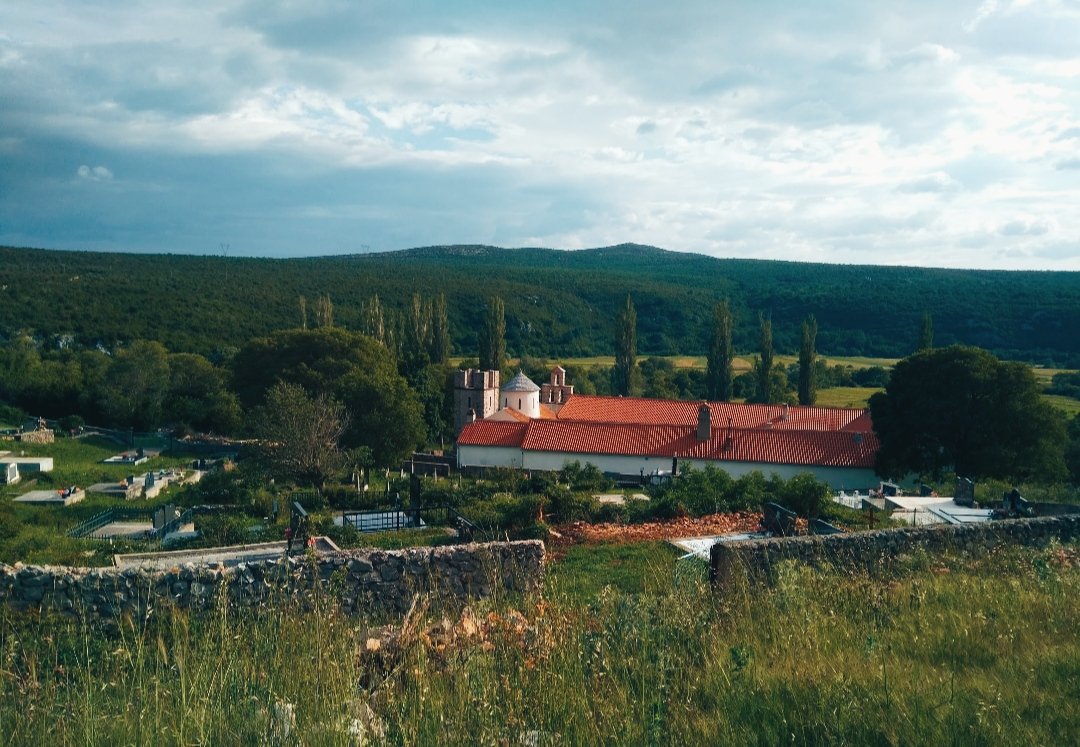
A stretch of the Velebit mountains | On the road to Krupa monastery | Krupa monastery
Several years ago, I returned to Dalmatia with my father and my husband after a decade of staying away. As in 1996, we found the house empty. My grandfather had just died, and so had my mother. The old blue wooden door was safely shut and my father unlocked it with a key, letting in the soft evening light.
One of the stops on this tour of his homeland was Krupa, an Orthodox monastery nestled by the eponymous river. It was already evening when the three of us reached the place. We walked around the small complex, and as we were inspecting the front portal of the church, the door opened and a bearded young man with a cigarette pack stuffed in the front pocket of his polo shirt stepped out. He introduced himself as a new priest and told us that the evening liturgy was about to begin. He invited us to join.
We were a most unlikely congregation: my father, a self-proclaimed atheist who didn’t know how to make a proper sign of the cross; my husband, another atheist from a Sunni Muslim background; and I who was formally baptized in the Catholic Church but did not consider myself a member. We obliged, though, and settled by the entrance, from where the last rays of the setting sun illuminated the fading centuries-old frescoes.
The scene was surreal and yet entirely natural. It was something akin to an enactment of the early modern history books with which I set out on this journey, an example of the crossing of religious lines and the ultimate exercise in ambiguity. In an almost comical evocation of a triple borderland, we embodied the three religious affiliations that had historically defined the region. The mosques are long gone from Dalmatia, but the traces of the religious intermingling persist, perhaps most curiously in the names of the nearby villages Islam Grčki and Islam Latinski.
I wondered then what kind of a historical record we would represent to a future historian and I laughed at the possible anthropological definitions that would befall us. I thought how much I loved history and how much solace it had given me over the years, and yet I also marveled at its inability to capture moments that make us human in all their simplicity.
We sat there, listening to the quiet recitation that mixed with the sounds of sheep bells scattered around the surrounding hills, ready for evening repose. The rhythmic ritual embraced us; the priest spoke for us, breaking the silence like a long overdue breaking of the fast. Words flew and echoed. They melted into the wind, freeing for once, rather than threatening.



